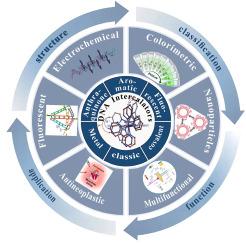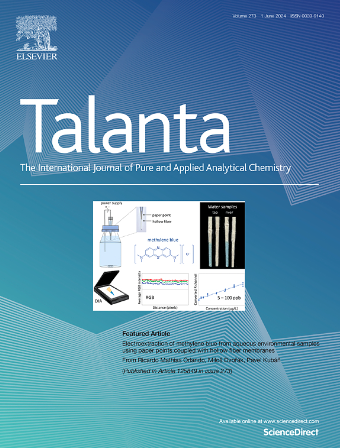传感器技术中dna插入器的研究进展:机制、应用和创新
IF 6.1
1区 化学
Q1 CHEMISTRY, ANALYTICAL
引用次数: 0
摘要
dna插入物由于其独特的插入核酸碱基对之间的能力,导致可测量的光学或电化学变化,在传感器技术领域引起了相当大的关注。分子生物学、纳米技术和光电传感的最新进展已经将DNA插入物的应用范围从抗癌药物开发扩展到生物传感和环境监测。它们能够通过荧光、比色和电化学信号转导对目标分子进行高度敏感和特异性的检测。然而,关于它们在传感中的作用的全面审查仍然有限。本文就其分类、作用机制、生物传感应用现状及未来研究方向进行了综述。结果DNA插入器是一类能够插入和特异性结合DNA双螺旋碱基对的分子,在分子生物学、药物发现和检测技术中有着广泛的应用。本文综述了DNA插入物的起源和作用机制,重点介绍了它们的分类及其在分析和生物医学应用方面的最新进展。dna插层器在传感器开发中具有重要的价值,特别是在重金属离子检测、特异性核酸序列识别以及通过荧光、比色和电化学信号转导进行药物筛选方面。最后,文章总结了目前研究的局限性,并展望了新型低毒插入剂和多靶点检测平台的发展。本文综述对促进dna插层剂的发展具有重要意义,并为dna插层剂的研究和应用提供参考。本文章由计算机程序翻译,如有差异,请以英文原文为准。

A review on advances in DNA-intercalators for sensor technologies: Mechanisms, applications, and innovations
Background
DNA intercalators have attracted considerable attention in the field of sensor technology due to their unique ability to insert between base pairs of nucleic acids, resulting in measurable optical or electrochemical changes. Recent advancements in molecular biology, nanotechnology, and optoelectronic sensing have expanded the applications of DNA intercalators beyond anticancer drug development to include biosensing and environmental monitoring. They enable highly sensitive and specific detection of target molecules through fluorescence, colorimetric, and electrochemical signal transduction. However, comprehensive reviews on their role in sensing remain limited. This review summarizes their classification, mechanisms, recent biosensing applications, and future research directions.
Results
DNA-intercalators, a class of molecules capable of inserting between and specifically binding to DNA double-helix base pairs, have attracted attention for their wide range of applications in molecular biology, drug discovery, and detection technologies. This paper reviews the origin and mechanisms of action of DNA intercalators, with a particular focus on their classification and recent advances in analytical and biomedical applications. DNA-intercalators have shown significant value in sensor development, especially in heavy metal ion detection, specific nucleic acid sequence recognition, and drug screening through fluorescence, colorimetric, and electrochemical signal transduction. Finally, the article summarizes the limitations of current research and looks forward to the development of novel low-toxicity insertion agents and multi-target detection platforms.
Significance
This review is significant for promoting the development of DNA-intercalators and provide a reference for the research and application of DNA-intercalators.
求助全文
通过发布文献求助,成功后即可免费获取论文全文。
去求助
来源期刊

Talanta
化学-分析化学
CiteScore
12.30
自引率
4.90%
发文量
861
审稿时长
29 days
期刊介绍:
Talanta provides a forum for the publication of original research papers, short communications, and critical reviews in all branches of pure and applied analytical chemistry. Papers are evaluated based on established guidelines, including the fundamental nature of the study, scientific novelty, substantial improvement or advantage over existing technology or methods, and demonstrated analytical applicability. Original research papers on fundamental studies, and on novel sensor and instrumentation developments, are encouraged. Novel or improved applications in areas such as clinical and biological chemistry, environmental analysis, geochemistry, materials science and engineering, and analytical platforms for omics development are welcome.
Analytical performance of methods should be determined, including interference and matrix effects, and methods should be validated by comparison with a standard method, or analysis of a certified reference material. Simple spiking recoveries may not be sufficient. The developed method should especially comprise information on selectivity, sensitivity, detection limits, accuracy, and reliability. However, applying official validation or robustness studies to a routine method or technique does not necessarily constitute novelty. Proper statistical treatment of the data should be provided. Relevant literature should be cited, including related publications by the authors, and authors should discuss how their proposed methodology compares with previously reported methods.
 求助内容:
求助内容: 应助结果提醒方式:
应助结果提醒方式:


